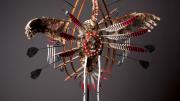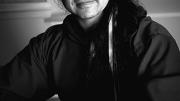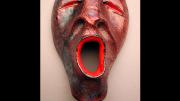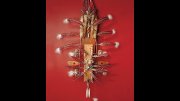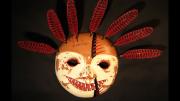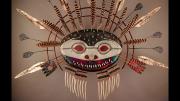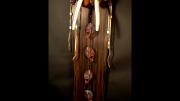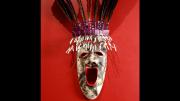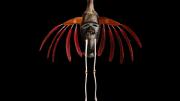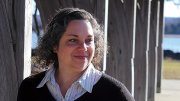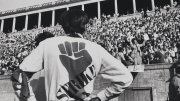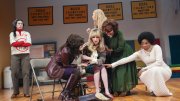Twelve years ago, Phillip Charette, M.Ed. '94, spent his days in an office, handling visa applications and other logistical concerns for international students, faculty, and staff at the University of Wisconsin-Madison. Now he makes his living as an artist, crafting sculptures that combine elements of his Native Alaskan heritage with his own modern touches.
Charette's French-Canadian last name comes from his father, but his mother is full-blooded Yup'ik, an indigenous group that today has an estimated 21,000 members spread across Alaska and Siberia. He grew up in Florida, but spent summers with his grandparents in Alaska; Yup'ik was his first language, and he was always interested in Yup'ik folklore. "When I was very young, I was kind of an odd duck," he says. "When all the other kids were outside running around, I would be inside listening to the elders tell stories."
As a boy, he was drawn to art, but his father, a federal agent, hoped that his son would choose a career with more financial security. So Charette pursued education administration, and managed to incorporate his interest in his Yup'ik roots: he worked at the University of Alaska, helping to develop a K-12 curriculum combining traditional and Western knowledge. He entered Harvard three years after finishing his undergraduate education; equipped with a master's degree, he saw his path leading to higher levels of university administration.
A 1997 medical appointment changed his course. Working 12 to 17 hours a day at the Wisconsin job, Charette recalls, left him feeling even more exhausted than anyone on such a schedule might expect. Though all the tests came back negative, Charette's doctor suspected his high-stress lifestyle would eventually make him sick: "He told me I would die of heart attack or stroke within five years," Charette says.
He quit his job the next day. Soon after, his then-wife got a job in eastern Oregon, where Charette still lives. While substitute teaching and mulling his next step, he enrolled in a pottery class and began to explore what would become his trademark style: pieces reminiscent of historical Yup'ik masks, but made from clay--the medium that appealed most to him--instead of wood. Since then, his work has won prestigious awards and been featured in a 2008 traveling exhibit of contemporary Native North American art.
His masks explore concepts such as the afterlife and the spirit world, Yup'ik mythology, family stories, and cultural commentary. "Phillip doesn't simply copy the historic masks," says the Montana Historical Society's Bill Mercer, who acquired one of Charette's masks for the Portland [Oregon] Art Museum when he was curator for Native American art there. "It's this wonderful, contemporary, updated version, transforming them into art but maintaining their sense of spiritual potency."
Like older masks found in ethnology museums, Charette's masks have a broad range of meanings and purposes. Some express ritual power; others are more like entertainment, encapsulating stories. "Just imagine that you don't have any media--no television, nothing," says Charette. "This was the media format" for the Yupiit. "Into it go stories, values, all the cosmology. It becomes a mnemonic device, the visual cue that helps you retain the knowledge."
Charette often performs traditional Yup'ik songs and dances when he lectures. He also explains the meaning of the symbols in his work, shares insights from his research in the Smithsonian Institution's Native American collections and elsewhere, and draws analytic comparisons to other artistic traditions. In this approach, he sees the imprint of his time at Harvard--and his interest in academia is not altogether defunct: he hopes to earn a master's in fine arts and teach at the college level.
He makes his art in Baker City, a community of 10,000 on the historic Oregon Trail. The rural environment suits him. When he lived in Portland, the dense smoke produced by raku glazing (a technique of Japanese origin that uses extremely high temperatures and incorporates minerals to form a metallic finish) and horsehair firing (heating porcelain to 1,000 degrees and dropping individual hairs onto it to burn a pattern into the surface) irritated the neighbors.
Charette sees himself as a conduit, more than an artist giving life to his own vision. "The pieces shape themselves," he says. "Sometimes it just happens, and I can't tell you how or why."
